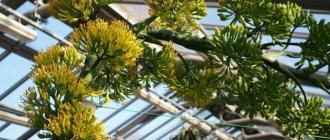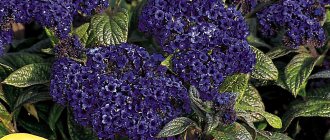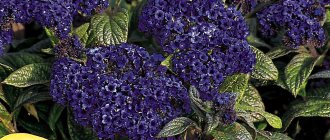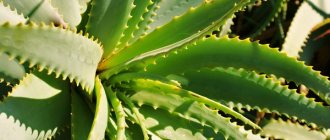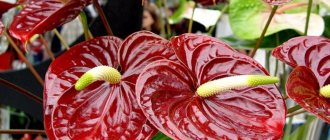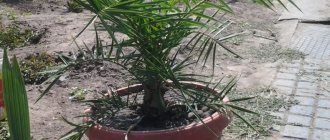Growing this plant since the second half of the twentieth century, breeders have developed various new hybrid varieties. New varieties of flowers differ in color and shape from the original plant.
Anthurium Andre is native to Ecuador, southern Colombia.
It can grow in the tropical part, on the slopes of rocky mountains; some specimens sometimes grow at an altitude of two thousand meters.
Description of Anthurium
Anthurium Andre or Anthurium Andrianum are evergreen plants of the Araceae family. There are many varieties of them, approximately 900.
They have leathery foliage and come in different shapes. The flowers are collected into a spadix. The cob has a leaf-veil. The bedspread comes in different colors and is heart-shaped.
Attention! The plant requires quite careful care, it is difficult to grow at home; some types of flowers can only be grown in heated greenhouses.
Why did the flower receive a specific nickname?
As already mentioned, for girls seeking to find family happiness, this flower helps in attracting male energy into the house. It is believed that blooming anthurium is a guarantee of a happy and harmonious life for spouses. Some especially impressionable people believe that the plant can even help with the problem of alcohol abuse and get rid of the addiction.
Why did “male happiness” get its popular name? It's all about the form. A pistil sticks out in the center of the opened heart-shaped bud, reminiscent of the moment of manifestation of male power. Anthurium flowers symbolize potency, power, masculine strength and performance.
It is believed that it is during the flowering period that the plant reaches the peak of its magical abilities. At this time, it actively attracts good luck, joy, happiness, love into the house, helps to restore the brightness of the colors of the world and the taste for life and realize the plans.
Types and varieties with names and photos
Favorite
The plant is tall and has leathery foliage. The flowers have a pinkish veil, maybe salmon-colored. And the corolla is pale violet-red, it has a pink tip.
Silence
The bract is snow-white or pale cream, and the inflorescences are pale yellow. This houseplant has broad, dark green foliage.
The flower
cannot withstand strong light .
Leganza
The plant has oval foliage with pointed tips. The flowers are bright orange or yellow.
The bract is pinkish or coral in color, but with a green border.
Adrios Red
Has a scarlet coverlet.
Otazu
It has a bright yellow inflorescence and a dark red bract.
Champion
It has large leaves. And the bract is pinkish or snow-white.
Belize
The plant has an intense yellow inflorescence and a dark red bract with a greenish border.
Mix
This is a hybrid bred by crossing various varieties of anthurium.
Arizona
The plant has scarlet bracts and yellow inflorescences.
Florida
The plant has reddish-orange bracts that are green at the end.
Polaris
It has white-green bracts.
Minnesota
The bracts are scarlet, have a yellow border, and yellow inflorescences.
Acropolis
The bracts are snow-white.
Lunette
The bracts are soft pink, and the inflorescences are a deeper shade of pink.
Sensa
The bracts are purple and the inflorescences are dark purple.
Transfer
Prepare a new pot with drainage holes and fill it with soil.
Before transplanting, water the flower thoroughly, then the soil will be softer and the root will be easier to remove from the container. If you have a plastic pot, you can lightly tap it on something hard.
Afterwards, the anthurium is removed, inspected and placed in a new pot.
Important! Replanting is required if roots are visible from the drainage holes and on the soil surface. It is better to choose a pot that has the same height and diameter.
If you transplant a flower into a pot that is too spacious, you will wait a very long time for the anthurium to bloom, since it will not form flower buds until the roots grow into the new soil.
After transplanting, the flower is watered again, and sphagnum moss is sprinkled on top.
Home care
Lighting
Anthuriums require diffused lighting; the flowers tolerate partial shade well. Therefore, they need to be shaded from the sun's rays. Window sills in the east and northwest are perfect.
Temperature
In summer, the optimal air temperature for them is +20-28°C, but not lower than 18°C. And from the beginning of autumn to February, a temperature of +15-16°C is suitable for them.
But one variety of anthurium requires lower temperatures, the plants are called Scherzer anthurium hybrids. And in winter they are kept for 6-8 weeks at an air temperature of +12-16°C, during which time watering is reduced.
If you need the plant to bloom earlier, then in January the temperature is gradually increased to +20-25°C.
Watering
Water the flowers abundantly, but make an interval between waterings and wait for the top layer of soil to dry. But it is impossible for the lower layers of the earth to dry out.
Important! The flower is watered approximately once every 4 days with soft water at room temperature.
In order for the anthurium to bloom in winter, at the beginning of autumn, watering is gradually reduced, the relative air humidity should be 80-85%, and the air temperature +16-18°C.
Water the flowers with soft rainwater . If you water with tap water and lime, soften it.
Do not over-moisten the soil, as the plant's roots may rot. Also, do not allow the water in the pan to stagnate. After watering, immediately pour out excess water from the pan.
Soil and fertilizers
Make a substrate by mixing 2 parts humus, 1 part leaf soil, 1 part peat soil and 0.5 sand. Next, 15% of cones, charcoal, and sphagnum moss are added to the substrate to give the soil greater lightness and breathability. Anthurium requires slightly acidic soil with pH = 5.5-6.5.
Another substrate option is to mix equal parts of soil for flowers and special soil for orchids.
And also add sphagnum moss.
A mixture of sphagnum moss, peat soil and coconut fiber works well.
From the beginning of spring to the end of summer, anthurium is fertilized once every 2 weeks. First, in the spring, a weak solution for decorative deciduous plants is used for feeding, and after 2-3 such feedings they switch to others: Agprikola, Fertika-lux.
especially need fertilizing before the buds open . In winter, the plant is stopped fertilizing.
Possible difficulties
If you notice:
- spots on stems and foliage;
- wilted foliage;
- the plant does not bloom, its growth is slow.
This can happen due to excess moisture, improper soil composition, insufficient soil breathability, diseases or pests.
You need to water the plant and remove it from the pot. Remove the old soil, carefully examine the roots; if they are damaged or have begun to rot, then cut off the rotten areas and treat the wounds with charcoal powder.
Also inspect the stem and leaves, remove dried or yellowed leaves, cut off inflorescences and flower stalks. If signs of rot are visible on the plant, treat the flower with a fungicide.
Plant the plant in new soil and a new pot.
This video contains detailed and valuable tips on how to avoid possible problems with growing anthurium:
Why doesn't it bloom
- To flower, the plant must be kept in a room with a temperature of at least +18°C.
- The flower should not be placed in direct sunlight. The flower really does not like drafts.
- It is necessary that the volume of the pot be slightly larger than the volume of the roots, otherwise the plant will not bloom.
- Don't forget to fertilize the plant.
Reproduction
The indoor anthurium flower can reproduce in several ways, but the most effective is the use of children and division of the plant. Reproduction occurs in the spring during planting. The division is carried out using a sharp knife, and the sections are treated with crushed coal. After division, the plants are placed in different containers.
Watering is done carefully to prevent excessive soil moisture. It is effective to root a piece of stem containing a leaf and an aerial root. This cutting forms a root.
Seed propagation is also possible. However, not everyone can cope with the task in indoor conditions. When flowering begins, Anthurium should be pollinated by running a cotton swab over the cob. Cross-pollination is necessary for 2-3 days, repeating the procedure up to 3 times a day. After the berries appear, they wait until they ripen - approximately 9-12 months.
When propagating, you should take ripened seeds and clean them of pulp. Then they are planted in pots. Placed on top of the soil, the seeds are pressed a little and sprinkled with water. The seedlings are transferred to a greenhouse and wait up to 2 weeks.
- Ktenanta - types, cultivation characteristics and instructions for care at home. 110 photos of plants
Guzmania: planting, replanting, propagation of different species and rules for watering the plant. 135 photos of a flower and video tips for caring for it
Gloxinia: growing and care at home. 165 photos of a flower and rules for planting it
After the formation of the second leaf, a dive is performed, and after 2 months this is done again. When the seedlings have 5-6 leaves, they can be planted in pots. In the third year, flowering occurs, as can be seen in the photo of anthurium.
